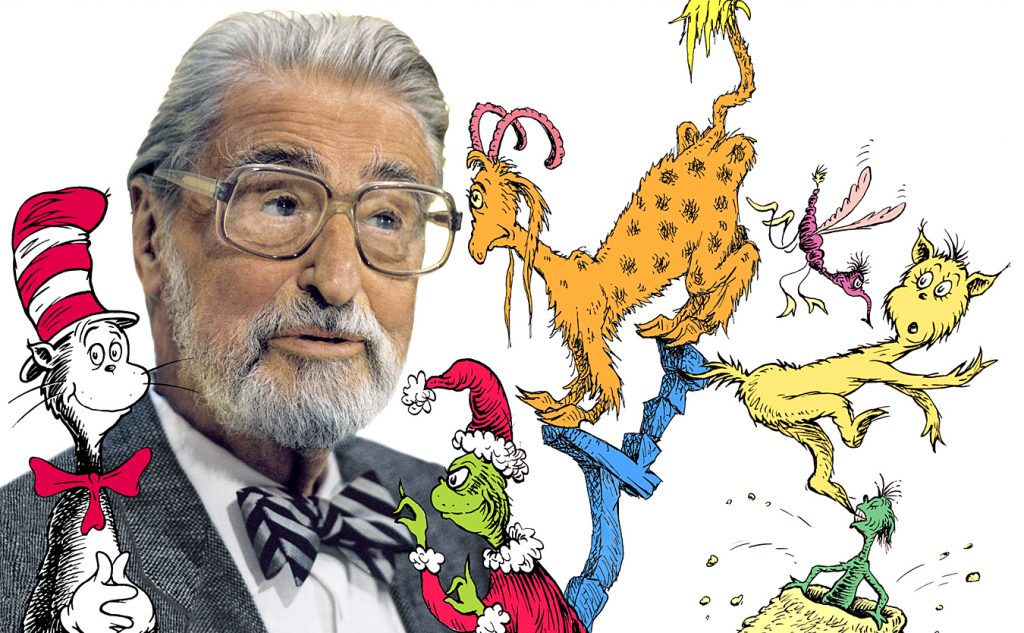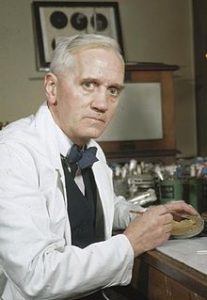Theodor Geisel, beloved children’s author, had a life before he put the hat on the cat. Born March 2, 1904, in Springfield, Massachusetts, Geisel was the only son of German-born immigrants. He spent a normal childhood with his sister and parents, before going to college to become a teacher. Geisel dropped out of college shortly before completing his doctorate in literature. He would eventually turn his almost doctorate and his mother’s maiden name into his now famous pen name, Dr. Seuss.1

In 1927, Geisel decided to turn his passion for drawing and writing into a career in advertising. One of his early successes in advertising was his drawing for Flit insecticide, whose mascot looked very similar to the cat that would eventually wear a striped hat.2 He later created an entire campaign for Essomarine Oil, a division of Standard Oil, called Seuss Navy, in which he designed certificates of membership, pamphlets, and even ashtrays and cocktail glasses that were passed out at trade shows. The Seuss Navy ads ran from 1936 to 1941, and contained many of the sea creatures that would later appear in his books.3 Geisel used many of his made up creatures in various ad campaigns and was the first person to use humor to sell products, altering the advertising industry.4

In 1941, Geisel left advertising to work as a political cartoonist for liberal New York newspaper PM. He drew over 4oo cartoons targeting such topics as isolationism, antisemitism, and racism. He routinely mocked Hitler and Mussolini, but he had a particular flair for attacking American nationalism as well. Believing that the American Nationalist Movement was just another form of fascism, Geisel made Charles Lindbergh a frequent subject of his cartoons.5 After the Japanese attack on Pearl Harbor, Geisel began to use his cartoons to support the war against Japan. He drew cartoons that “depicted Hideki Tojo, the Prime Minister and Supreme Military Leader of Japan, as an ugly stereotype, with squinting eyes and a sneering grin.”6 Geisel was in support of Japanese internment camps and drew several cartoons about them.

It can be hard to imagine that Dr. Seuss could be a racist in his depiction of Asians, but he later admitted that this was exactly the case. At the time, PM did not receive one letter of complaint about Geisel’s stereotypical depiction of Asians, although they received many letters when Geisel mocked the German dachshund, which was popular among American dog owners. Dr. Seuss later said that his 1954 book, “Horton Hears a Who,” written after a trip to Japan and dedicated to a Japanese friend, is meant to be an apology to the Japanese people for his depictions of them during World War II. In the 1980’s, Geisel looked through all his children’s books and removed anything he felt was racist, changing them for any future publication.7
Geisel’s political cartoons ended when he joined the Army in 1943. The now Captain Geisel was assigned to a unit that made training films for the Army, working with the likes of Stan Lee (creator of super heroes) and Chuck Jones (creator of the Road Runner and Wile E. Coyote).8 Geisel and Jones would become life long friends and would work together on various projects, including the animated “How the Grinch Stole Christmas,” which is still shown every year on television.

Geisel’s first children’s book was “And to Think I Saw It on Mulberry Street,” and was published in 1937. However, his writing career almost never happened. The book had been turned down by 27 publishers and Geisel was ready to give up the idea of becoming a children’s author when he ran into an old college friend while walking down the street. His friend had recently become an editor at Vanguard Press and asked Geisel to send him the book so he could show his boss. Geisel would later say in interviews that it was pure luck that he walked down that side of the street that day.9
Dr. Seuss later claimed that he did not like to write books that had a moral or ethical lesson, because children could see a lesson coming and would not want to read the book.10 However, all of Geisel’s books, except his Beginner Books, contained lessons of some sort. Dr. Seuss wrote books with lessons on environmentalism, racial equality, the pointlessness of the arms race, materialism, and respect, just to name a few. He was one of the first children’s authors to write books for children with the respect and care typically reserved for adult literature.11
Dr. Seuss died on September 24, 1991 at his home. He was asked shortly before he passed away to leave a message for children. He wrote “The best slogan I can think of to leave the kids of the U.S.A. would be ‘We can…and we’ve got to…do better than this.’ He then crossed out ‘the kids of.'”12 Dr. Seuss left a legacy of children’s literature that will not soon be forgotten, but he did more than that; Dr. Seuss taught children to think.
- Janet Schulman and Cathy Goldsmith, Your Favorite Seuss (New York: Random House, 2004), 6. ↵
- Louis Menand, “Cat People,” The New Yorker (December 2002). ↵
- Janet Schulman and Cathy Goldsmith, Your Favorite Seuss (New York: Random House, 2004), 55. ↵
- Janet Schulman and Cathy Goldsmith, Your Favorite Seuss (New York: Random House, 2004), 117. ↵
- Sophie Gilbert, “The Complicated Relevance of Dr. Seuss’s Political Cartoons,” The Atlantic (January 2017). ↵
- Sophie Gilbert, “The Complicated Relevance of Dr. Seuss’s Political Cartoons,” The Atlantic (January 2017). ↵
- Sophie Gilbert, “The Complicated Relevance of Dr. Seuss’s Political Cartoons,” The Atlantic (January 2017). ↵
- Janet Schulman and Cathy Goldsmith, Your Favorite Seuss (New York: Random House, 2004), 9. ↵
- Louis Menand, “Cat People,” The New Yorker (December 2002). ↵
- Janet Schulman and Cathy Goldsmith, Your Favorite Seuss (New York: Random House, 2004), 190. ↵
- Janet Schulman and Cathy Goldsmith, Your Favorite Seuss (New York: Random House, 2004), 84. ↵
- Janet Schulman and Cathy Goldsmith, Your Favorite Seuss (New York: Random House, 2004), 190. ↵



125 comments
Morghan Armenta
As a child we typically do not question the authors purpose for a work or the underlying themes that exist in our children’s books until we revisit these works as adults. This article was intellectually invigorating, you have reminded all of us of a greater theme surrounding many of our beloved children’s books. I wasn’t aware of Geisel’s political writing past, it makes sense that a talented writer during World War 2 would produce work that reflected there opinions on the climate of the society but even still this article gives a true biography to a author you would think you know well. Thanks for sharing the detailed information on Geisel’s idealology surrounding Japanese internment camps during his political career. Overall, this was a thoroughly interesting article that I was glad to of had the chance to read.
Karla Chavana
Although I have personally enjoyed Dr. Seuss unique creativity, this article opened my eyes to his “drive” or intentions for some of his writing. For instance, who would have ever thought that his ingenious, creative, and exciting book of “Horton Hears a Who” was a written apology for his selected depiction of racism? The Book and now movie offered the image of a world taken over and destined to the actions of an elephant. Dr. Seuss also gave the readers perspective by showing that in this world we are all particles in a big shared universe and that sometimes every world encounters havoc. Just like one encounters havoc in war. I have been a fan of Horton as long as I can remember, but after reading this article the book will always have an added sense of depth.
Alejandra Mendez
When I was younger and in elementary school, every year on Dr. Seuss’ day, my school would host this big Dr. Seuss event where students would very excitedly sit criss cross against the walls of the hallways and wait for The Cat in the Hat (a teacher in costume) to pass by with Thing 1 and Thing 2. The students, I being one of them, would reach out our hands to shake one of Dr. Seuss’ most famous characters. I now realize that although I knew of Dr. Seuss at the time, I didn’t fully know him. This article taught me so much about the famous author that I would have never imagined. It is also very inspiring and motivational to me that he stuck with his passion in writing and art and became very successful from it. A big point that was made that I had never known before is what his real name was. This was an overall very interesting and informative article.
Michelle Falcon
Growing up I was never much of a reader, except for when it came to Dr. Seuss! This article showed sides of “Dr. Seuss” that I never knew, such as the political side of Geisel. Before ” Green Eggs and Ham” and ” One Fish Two Fish Red Fish Blue Fish” were to political cartoons that became part of history by showing racial and anti-Semitism drawings . How ever that all come to change when Geisel started writing childrens books focusing on ” racial equality, materialism” and many more factors that were the foundation to the books that defined part of my childhood.
Ian Hammock
I was immediately drawn to read this article because the title indicated that the was something more to the man I presumed to be Dr. Suess. In fact, before this reading this article I had no knowledge of who Theodor Geisel (Dr. Suess) was other than a children’s book author. It is interesting to me that it wasn’t Geisel’s intention to be an author for children, the fact that he pursued other career paths before and after becoming a writer indicates that there is so much time left to figure out what the right career path is for me.
Alexis Soto
I enjoyed reading this article because it covered information I did not know I wanted to know. I believe most children in America are exposed to Dr. Seuss’s books at an early age. I cannot recall when or what my first Dr. Seuss book was read, except that I have known of his work since I can remember. Your article informed me of some fascinating facts about the famed children’s book writer. I did not know he served in the Military or that he worked on political cartoons. The most surprising of all was reading about his discriminatory actions against the Japanese.
Yahaira Martinez
When you’re little and growing up you’re attracted to the colors and the cartoons on the cover of Dr. Seuss’ books, and even reading them is fun. However after the years pass and you happen to come across an article like this its like a time machine that takes you back to the exact moment you would pick up those books but now you have a new perspective. This article made me gain more knowledge on the life of a beloved childhood author of many children and let us see what his life was like before success came for him. the most interesting part however is knowing that the creator of the silly cat in the hat also created political cartoons for world war 2. The idea of Dr. Seuss creating political cartoons is something that never even crossed my mind! Fun article, easy to follow and great pictures that allowed us to follow his journey and evolution of his work as we read.
Brianda Gomez
I have seen all of the Dr. Seuss movies and read some of his books throughout my childhood. This article enlightened me because I discovered many things about Dr. Seuss. It was also inspiring, although he was turned down 27 times he was still successful with help of an old friend. I also could not believe one of the most famous authors was not just a college dropout but that he also made political cartoons. The fact that most of his books contained a life lesson really filled my heart with joy that children all over the world are reading his books.
Briana Myers
When I read this article I was surprised by some of the things that I learned about Dr. Seuss. I had known that he made political cartoons but other than that my knowledge of him was not very extensive. I had no idea that he was indeed a racist and criticized the Japanese using stereotypes. I am glad to know that he later apologized for what he had said about them. I was also surprised to learn that it was by chance that he became the famous author he was by simply walking down the street and running into his old friend.
Amber Aragon Alvarado
Dr. Seuss was always a favorite author of mine, but I had no idea that he did so much more than write children’s books. Reading more about his life in general was really interesting. He demonstrated an example of mindset change is always possible considering the fact that he was once racist. It was strong and powerful of him to convey his apologies and be better as a human being in general. The fact that he was also in the military was truly fascinating to me. Dr. Seuss did so much more than influence younger children and thats something I never knew. I believe that Dr. Seuss became the best version of himself he could ever possibly be. The fact that change in him occurred made him realize and acknowledge that not only he was the one that needed to better, but so did the United States. Overall, it was a really interesting and inspiring article to read. I know a lot more about an author I’ve always looked up to.